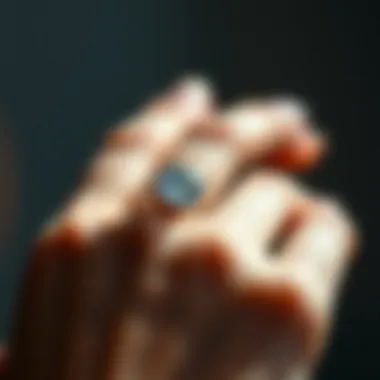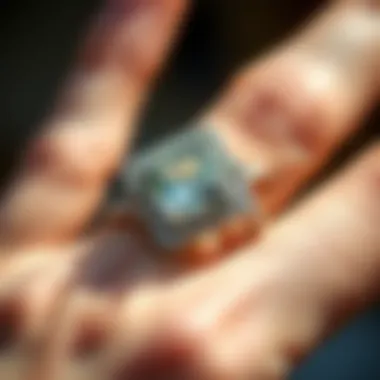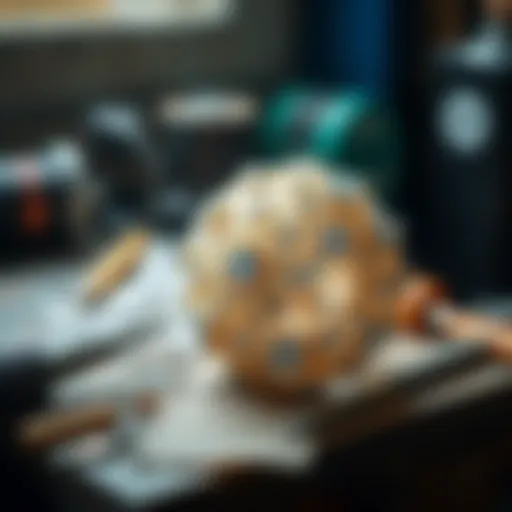Significance of the Engagement Ring Finger for Women


Intro
The tradition of wearing engagement rings on the fourth finger of the left hand is steeped in cultural, historical, and personal significance. This practice transcends time, weaving through various societies and adapting to modern sensibilities. Understanding why this finger—the ring finger—holds a special place in the hearts of many is an exploration that leads into the depths of love, commitment, and the symbolism of jewelry.
From ancient Rome to today’s contemporary styles, this article will guide you through the intricacies of this tradition. We'll touch on the earliest beliefs about the veins of love that supposedly run straight from the heart through this finger, delve into the kinds of gemstones that adorn these rings, and examine how personal choices shape the meaning of engagement jewelry.
By the end of this journey, you’ll grasp not just the reasons behind this revered practice but also the nuances that make each ring a unique testament to relationships.
Gemstone Overview
Definition and Origins
Engagement rings often feature various gemstones, with diamonds reigning supreme in modern customs. The term "gemstone" refers to precious or semi-precious stones that have been cut and polished for use in jewelry. These stones have been cherished by civilizations throughout history not merely for their beauty but also for their supposed powers and meanings.
Diamonds, which became popular in the late 19th century due to aggressive marketing campaigns by jewelers, symbolize strength and eternal love. However, historical headliners included sapphires, emeralds, and rubies, each bringing distinct qualities and significance to the wearers.
Historical Significance
The earliest known usage of gemstones in engagement rings dates back to ancient Rome, with rings made of iron and later gold. As customs evolved, so did the stones. In the past, gemstones were believed to possess protective powers. For instance, the ancients thought sapphires could shield against envy, while emeralds were thought to confer fertility and healing.
Interestingly, the use of rings can also be traced back to ancient Egypt, where they represented eternity due to their circular shape. So, when you slip a ring onto that fourth finger, remember you are participating in a tradition that has weathered centuries and embraced the myriad nuances of love and partnership.
Gemstone Properties
Hardness and Durability
Understanding the hardness and durability of gemstones is crucial when selecting an engagement ring, as these pieces are often worn daily. Gemstones are ranked on the Mohs scale of hardness, which ranges from 1 (talc) to 10 (diamond). Diamonds top this list, making them the most durable choice for a ring that is intended to last.
Sapphires and rubies, both varieties of corundum, offer high durability as well. With a Mohs rating of 9, they hold their own against everyday wear. However, softer stones like opals and pearls, while beautiful, may not be ideal for everyday rings due to their fragility.
Color and Clarity
When choosing a gemstone, color and clarity stand as two vital aspects. Color is often subjective, and each buyer may have personal favorites. The most admired diamonds display a clear, colorless quality, whereas gemstones like sapphires are prized for their deep blue shades.
Clarity, on the other hand, refers to the presence of inclusions or blemishes that may affect the stone's appearance. A flawless diamond might be a benchmark, but many people appreciate the character that inclusions bring to certain gemstones.
"A beautiful stone is not merely defined by its absence of flaws but by the stories it carries."
Cultural Significance of Engagement Rings
Engagement rings hold a profound significance in various cultures, serving as more than just pieces of jewelry. For many, they symbolize a deep personal commitment and connection between partners. This section delves into the importance of engagement rings, particularly focusing on their cultural context and the symbology that underpins these cherished items.
Historical context of engagement rings
The history of engagement rings is steeped in tradition, dating back thousands of years. In ancient Rome, men would gift rings to their betrothed as a pledge of their union. The rings, often made from iron, represented strength and permanence. Fast forward to the Middle Ages, where it became customary for a man to offer a diamond ring to his chosen partner, symbolizing her beauty and his devotion.
As time went on, diamonds became the stone of choice, especially after the famed De Beers advertising in the 20th century cemented their association with love and commitment. Each era has refined the styles and materials used, yet the essence of what these rings represent has remained a constant throughout history.
Symbolism of the ring
The engagement ring itself is infused with meaning, particularly through its symbolism. Three key aspects stand out:
Love
At its core, the engagement ring symbolizes love, which is the fundamental aspect of any romantic relationship. This type of love goes beyond mere attraction; it encompasses loyalty, kindness, and a deep emotional connection. A well-chosen engagement ring showcases this sentiment in a physical form, often reflecting the personal stories and unique experiences shared between the couple. While love is a noble feeling, it can have its challenges. It can be difficult to express the depth of love through material means, which is why selecting the right ring is crucial.
Commitment
Commitment takes the notion of love to the next level. An engagement ring is not just a token; it signifies a promise to stand by each other through thick and thin. The circular shape of the ring itself is significant, suggesting that love and commitment have no beginning or end. When couples choose their rings, they often consider aspects like durability and style which reflect their commitment to one another. Despite being a powerful sign of fidelity, some may feel pressure to conform to societal expectations when choosing a ring, which can complicate this otherwise personal choice.
Eternity
The symbolism of eternity creates a powerful connection to future possibilities. Engagement rings are often seen as a promise of forever, representing the hope for a long-lasting partnership. This concept of eternity is frequently conveyed through the use of certain stones or designs, such as eternity bands completely encircled by gems. While eternity rings express an ideal, it's essential to understand that the journey of every relationship may have ups and downs. Thus, while they celebrate lasting love, they should also remind couples to nurture their relationship over time.


“An engagement ring is not merely a piece of jewelry, but a profound emblem of love, commitment, and eternity; a story told in metal and stone.”
Understanding the cultural significance of engagement rings allows individuals to appreciate that these tokens go beyond their monetary value. They embody personal stories, emotions, and timeless promises that resonate with the very fabric of human connection.
The Proliferation of Ring Styles
The world of engagement rings has blossomed into a rich tapestry of designs, reflecting personal tastes, cultural influences, and evolving social norms. This section dives into the significance of how styles proliferate, showcasing the key elements that define traditional and modern ring designs. As society changes, so do the expectations surrounding these symbols of commitment. The variety available today offers something for everyone, ensuring that each individual can select a style that resonates deeply with their values and personality.
Traditional vs. modern designs
Traditional engagement rings typically exude a sense of timeless elegance, often featuring a single brilliant diamond set in a classic setting, such as a solitaire or a simple halo. These rings symbolize enduring love with their understated yet striking appeal. For many, these styles are reminiscent of the rings worn by past generations, carrying with them rich family legacies.
On the other hand, modern designs take bold steps, introducing innovations like unconventional stone shapes, vibrant colored gemstones, and unique settings. These rings often capture the wearer's distinct personality – think about the rising popularity of geometric designs or rings made from alternative metals like titanium and cobalt. The appeal of modern engagement rings lies in their ability to reflect personal stories, from eco-friendly materials to handcrafted pieces showcasing artisanship.
Both traditions have their merits, and the growing trend of mixing elements from various styles creates an even more diverse offering. Rings can now be customized to blend these historical designs with contemporary flair, allowing individuals to express their sentiment in a way that feels perfectly aligned with their identity.
Customization and personal expression
Customizing engagement rings is where personal expression truly shines. This unique aspect allows couples to create a piece that speaks to their love story, transcending the generic options found in most jewelry stores. Customization also gives way to unique craftsmanship that can make a ring feel one-of-a-kind, even among a sea of options.
Engraving
Engraving is a popular choice for those looking to add a personal touch to their ring. This practice involves inscribing text or symbols onto the band, providing a deeper connection to the piece. Many couples choose to engrave meaningful dates, initials, or even lyrics from their favorite song. The key characteristic of engraving is that it adds a layer of intimacy to the ring, transforming it from a mere accessory into a cherished keepsake.
What makes engraving beneifical? It allows individuals to carry a bit of their personal life with them wherever they go. However, one important consideration is that the added weight of the engraving can potentially affect the comfort of wearing the ring. Finding the right balance between embellishment and ease should always be the priority.
Unique settings
In the realm of Unique settings, every detail matters. A setting is not just functional; it can completely transform the overall aesthetic of the ring. From intricate filigree work to bold, asymmetrical placements, settings can enhance the stone's brilliance while also making a statement about the wearer’s style. This diversity is key because unique settings appeal to those who crave individual expression.
What makes unique settings popular? They allow for creativity and freedom in ring design, showcasing craftsmanship that draws attention. However, one must consider that some settings may require more care and maintenance. While they catch the eye, ensuring that a decorative setting does not compromise the ring's durability and long-term wearability is essential.
"In essence, the proliferating styles of engagement rings provide a canvas for expressing both individual spirit and collective tradition, creating a modern narrative interwoven with the past."
In summary, the variety of engagement ring styles continues to expand as couples seek pieces that align with their personal narratives. Both traditional and modern designs play a vital role in shaping these choices, combined with the freedom of customization that brings forth authentic connections to each piece.
The Fourth Finger on the Left Hand
The tradition of wearing engagement rings on the fourth finger of the left hand holds deep significance in many cultures. This custom isn't just arbitrary; it symbolizes love and commitment in a very tangible way. This finger, often referred to as the "ring finger," is said to house a vein that flows directly to the heart, a notion that gives a poetic touch to why it is chosen for such a meaningful gesture. Understanding this choice provides insight into why we attach so much meaning to this specific finger and what it represents in terms of relationships.
Origins of the tradition
The roots of wearing engagement rings on the fourth finger trace back to ancient civilizations. It seems that the Egyptians were among the first to believe that this finger had a direct connection to the heart. They honored their loved ones by placing rings on this particular digit, which accented their heartfelt intentions. This idea was later echoed by the Romans, who adopted the custom, believing that the ring represented a binding contract between lovers.
Over the years, this belief has been interwoven into various wedding practices around the globe. The enduring nature of this tradition reflects how love has always been held in high regard across cultures. While its meaning has evolved, the fourth finger remains a powerful symbol of romantic commitment, resonating with many, young and old alike.
Cultural variations in finger choice
Western traditions
In Western cultures, the practice of wearing engagement rings on the fourth finger of the left hand is predominant. The style of rings also often reflects personal taste, but specifically the left hand is revered as the standard for engagements. Wedding traditions here typically incorporate both engagement and wedding rings into this finger, emphasizing continuity.
Key characteristics of Western traditions include:
- The continuity of wear: Many Western couples choose to wear the engagement ring during the wedding ceremony, maintaining the sentimenet of that first promise.
- Luxury designs: Engagement rings here are often diamond-centric, showcasing the classic brilliance and transformative power of precious stones.
- The wedding band: Typically, the wedding band is placed on the same finger, creating a stack that symbolizes both engagement and marriage.
This choice serves as a public declaration of commitment; it allows partners to display their love openly in a society that values visible symbols of relationships.
Eastern practices
Eastern practices highlight significant differences when it comes to finger choices for engagement ring wearing. In several cultures, notably in countries like India and China, the engagement ring is not worn on the left hand's ring finger at all. For instance, many Indian traditions center engagement jewelry around personal significance and family heritage rather than the typical Western model.
Key characteristics of Eastern practices include:
- Diverse placements: Engagement rings can also be found on other fingers or not worn at all during the engagement, depending on familial customs.
- Focus on family stones: In many cultures, jewelry is imbued with familial meaning, with pieces being passed down rather than newly bought.
- Material significance: The presence of gold and colored gemstones often takes precedence over diamonds in these cultures, reflecting local customs and preferences.


These practices underscore how love and commitment can manifest differently around the world. The variations remind us that love is universal yet deeply personal, colored by cultural narratives that shape human connection.
Alternative Choices for Engagement Rings
As we delve into the choices available for engagement rings, it becomes clear that opting for alternative options rather than the traditional fourth finger on the left hand opens up a world of personal expression and significance. The trend of engagement rings has evolved beyond simple convention, embodying individuality and different meanings, depending on the finger on which the ring is worn.
Whether to honor cultural practices, make bold fashion statements, or simply to enjoy the comfort of function over form, the significance of where a ring is placed can enhance the experience of engagement for many.
Different fingers and their meanings
When it comes to choosing the finger for an engagement ring, different fingers can convey various meanings. While the fourth finger is most widely accepted, wearing a ring on another finger can resonate with personal beliefs or cultural values.
- Middle Finger: Wearing a ring here often symbolizes balance in life, as it is the finger between the index and ring finger.
- Index Finger: Traditionally associated with leadership and influence, an engagement ring on the index finger might suggest taking charge of one’s destiny.
- Thumb: This choice is quite unconventional but can denote strength and self-assertion, showcasing a sense of independence.
- Pinky Finger: Often associated with family and heritage, a pinky ring could signify the importance of lineage or a promise to maintain familial bonds.
Each choice resonates with unique meanings, allowing individuals to break away from tradition while still honoring personal attributes or beliefs.
Materials and stones
Engagement rings nowadays go beyond diamond standards, with numerous materials and stones creating a diversified landscape in the jewelry market. Choosing the right materials plays a significant role in the overall character of the engagement ring.
Common gemstones
Gemstones like sapphires, emeralds, and rubies are becoming increasingly popular for engagement rings. Each of these stones holds its own distinct significance.
- Sapphire: Known for representing wisdom and nobility, a sapphire engagement ring can symbolize loyalty and trust, essential qualities in a relationship.
- Emerald: This gemstone is often linked with love and rebirth. Its mesmerizing green hue can evoke feelings of vitality and freshness in a budding relationship.
- Ruby: Recognized as a stone of passion, rubies signify deep love and devotion. It is a vibrant and bold choice that reflects strong emotions.
The unique features of these gemstones come with both advantages and disadvantages. For example, sapphires are generally more durable than rubies, which might need extra care. Understanding these factors can guide discerning buyers.
Trending materials
As modern consumers demand ethically sourced materials, the rise of lab-grown diamonds alongside unique alternatives is notable. These trending materials not only reflect contemporary values but also appeal to a growing base of environmentally conscious buyers.
- Lab-grown diamonds: These stones carry the same chemical composition as natural diamonds yet come without the significant environmental impact. They often cost less than their mined counterparts."
- Moissanite: Known for its brilliance and fire, moissanite is a popular alternative offering incredible sparkle at a fraction of the price.
- Recycled metals: Utilizing materials from old jewelry supports sustainability, enabling the creation of new, beautiful pieces without requiring new resources.
Utilizing these trending materials can make a profound statement about the wearer’s values while maintaining the beauty and sentiment behind the engagement ring.
Engagement rings, whether worn on the traditional fourth finger or otherwise, come with layers of significance that reflect personal choices, cultural expressions, and environmental considerations. As engagement ring practices evolve, it embodies a societal shift toward individuality and sustainable, thoughtful selections.
Practical Considerations in Ring Wearing
When it comes to wearing engagement rings, the discussions often hover around their cultural significance or aesthetic appeal. Yet practical aspects shouldn't take a back seat. Comfort and fit can make or break the experience of wearing such meaningful jewelry. A ring should feel like a natural extension of oneself rather than a cumbersome accessory. If ill-fitting, a ring might induce discomfort or even enhance the risk of losing it. Thus, it’s essential to ensure both a snug yet comfortable fit, keeping in mind that some individuals might experience fluctuations in finger size due to several factors including temperature changes and weight fluctuations.
Another key point is care and maintenance. Engaging in proper cleaning routines not only preserves the ring's brilliance but also upholds the symbolism it carries. A well-maintained ring reflects care and consideration, qualities foundational in relationships. Without adequate attention to these details, even the most stunning pieces can lose their luster over time.
Comfort and fit
Finding the right fit isn’t just a matter of aesthetics; it can greatly influence the daily experience of the wearer. Rings that are overly tight can cause skin irritation, while rings that are too loose may slip off during routine tasks. A comfortable fit means being able to wear the ring throughout the day without the distraction of constant readjustment.
Tips for achieving the perfect fit:
- Sizing: Have a professional jeweler measure your finger accurately, taking into account seasonal changes.
- Style considerations: Wider bands may fit more snugly than narrower ones, and certain styles can feel more comfortable based on personal preferences.
- Material awareness: Different materials, like gold or platinum, might feel different on the skin. Some people are sensitive to particular metals.
Care and maintenance
Maintaining the integrity of an engagement ring involves a combination of cleaning and careful attention to how it's stored. This goes beyond merely keeping it shiny; it addresses the health of the stone and metal, prolonging the lifespan of the piece.
Cleaning methods
Cleaning methods for engagement rings hinge on both simplicity and effectiveness. Regular cleaning is vital not just for looks but also for ensuring the ring remains secure.
- Common practices: A gentle soap solution mixed with warm water is a popular choice. Submerging the ring and gently scrubbing it with a soft brush can help remove dirt.
- Professional cleaning: At least once a year, it's wise to have the ring cleaned by a jeweler. This ensures that any deep-set dirt is removed without risking damage.
“A little care goes a long way in maintaining the sparkle and shine of your cherished ring.”
Storage solutions


Proper storage solutions are equally important to prevent damage when the ring is not being worn. It is essential to create an environment that minimizes risk from scratches or unforeseen accidents.
- Ring boxes: A dedicated box with soft padding can prevent movement and impacts that could scratch the ring.
- Separation: Avoid storing rings together, as this can lead to scratches and other forms of damage.
- Climatic considerations: Jewelry should be kept away from areas with extreme temperatures or moisture, which can affect the integrity of both the metal and the gemstone.
In essence, being mindful of comfort and maintenance dramatically affects both the experience of wearing an engagement ring and the structural integrity of the piece itself. Ensuring a proper fit along with establishing a routine for cleaning and storage solidifies the ring as both a symbolic and practical accessory.
Personal Preference vs. Tradition
The ongoing tug-of-war between personal preference and tradition in choosing an engagement ring is a noteworthy discussion point. While tradition has a long-standing grip on how we perceive rings, personal taste is carving its own niche in today’s society. This delicate balance between the two plays a pivotal role in defining both what an engagement ring symbolizes and how it is selected by individuals. In this section, we’ll examine how personal choice impacts ring selection while still respecting conventional norms that have held sway for centuries.
The role of individuality in selection
Individuality in the selection of an engagement ring cannot be overstated. Each person has unique tastes shaped by personal experiences, values, and aesthetic preferences. This individuality often leads to a preference for non-traditional designs that reflect one's personality, such as colored gemstones, unique settings, or unconventional materials.
For instance, consider Sarah, who chose a vintage-style sapphire engagement ring instead of a traditional diamond. Her choice was influenced by her passion for antique jewelry and her desire to stand out in a world saturated with similar styles. In the same vein, other brides may opt for minimalistic designs or rings adorned with intricate engravings that speak to their life stories or shared memories with their partners.
Choosing a ring imbued with personal meaning fosters a deeper connection to the piece itself. Individuals feel a sense of pride in wearing something that not only symbolizes their commitment but also resonates with their individual identity. This element of personalization is crucial for many couples today when considering their future together.
Navigating societal expectations
Society has its share of expectations around what an engagement ring should look like, and this can sometimes create tension for those who wish to diverge from conventional norms. Many feel pressured to adhere to the societal standards that dictate the ‘correct’ materials and styles, often influenced by cultural narratives and peer perceptions.
However, it's essential to navigate these expectations thoughtfully. Couples can start by openly discussing their aspirations regarding the ring. This can lead to a blend of personal preferences wrapped in meaningful traditions. For example, while some couples may still prefer a diamond on the left hand, they might consider a unique setting or an ethically sourced stone, blending respect for tradition while honoring personal values.
Engaging in this dialogue allows partners to make choices that reflect their collective identity rather than being confined to external pressures. In essence, navigating societal expectations need not be a battleground between personal preference and tradition, but rather a collaborative journey towards finding something that resonates with both individuals.
"In the end, a ring should be a reflection of the bond shared, embodying both love and personal meaning."
Ultimately, the tension between personal preference and tradition in engagement ring selection emphasizes an important cultural shift. Couples are more empowered than ever to prioritize their unique stories over outdated norms, redefining what commitment looks like in their own contexts.
Emerging Trends in Engagement Ring Practices
Today, the realm of engagement rings is witnessing a significant transformation, evolving to reflect not only individual tastes but also crucial societal values. As more people seek customization and meaning behind their jewelry choices, emerging trends take center stage in engagement ring practices. These trends do not merely represent fashion; they echo a deepened understanding of personal values, ethical considerations, and a desire for uniqueness. Thus, recognizing these shifts is essential for anyone engaging with the world of engagement rings, providing insight into the motivations and preferences of modern couples.
Sustainable and Ethical Considerations
In recent years, sustainability has moved from the periphery to the forefront of conversations surrounding engagement rings. Consumers are increasingly aware of the impact their purchases have on the environment and society. The quest for sustainability encompasses various factors, leading many to opt for rings that are ethically sourced and environmentally friendly.
People are becoming mindful of where their diamonds and other gemstones come from. This raises questions about mining practices and labor rights. For instance, engagement rings made from recycled materials are gaining popularity. By choosing such rings, buyers help minimize the environmental footprint. Moreover, the story behind a ring can add emotional depth, making these pieces more than just ornamental items.
Additionally, couples are often inclined to explore moissanite or lab-grown gemstones, which offer stunning beauty with lesser ecological implications. These alternatives often come at a more accessible price point, allowing couples to obtain visually striking rings without compromising their values.
Emphasis on Lab-Grown Diamonds
As the engagement ring landscape evolves, lab-grown diamonds are coming into play, offering a fresh perspective on this ancient symbol of love. Created through advanced technology in controlled environments, these diamonds are chemically identical to their mined counterparts. This development provides an alternative that appeals to both ethical sensibilities and budget considerations.
Lab-grown diamonds are often substantially cheaper than mined diamonds, providing the opportunity for couples to acquire larger stones or exceptional quality without breaking the bank. As a result, people can focus on selecting designs that truly resonate with them instead of feeling constrained by price.
"The rise of lab-grown diamonds marks a pivotal moment in the jewelry world, merging beauty with conscience, allowing couples to make a statement with their choices."
The trend toward lab-grown diamonds does not diminish the emotional significance of an engagement ring; instead, it enhances it by allowing individuals to choose a diamond that aligns with their personal beliefs and financial realities. This reflects a broader shift in how individuals view the concept of love and commitment—favoring authenticity and personal connection over traditional norms.
Culmination: The Evolving Symbolism of Engagement Rings
The journey through the significance of engagement rings, particularly on the left-hand fourth finger, paints a nuanced picture of our values and traditions. This article highlights how these rings have transformed from mere adornments into deep symbols of love, commitment, and individual expression. As we explore the future of engagement rings and reflect on personal stories tied to these pieces of jewelry, it becomes clear that the meanings we attribute to them remain fluid.
In today's society, engagement rings can mean a great deal more than just an accepted token of promise. They often reflect personal stories, heritage, and even environmental consciousness, especially with the rise of sustainable and ethical practices in jewelry-making. The challenge lies in balancing the rich traditions that weigh heavily upon these bands with the innovative impulses of a new generation seeking to redefine them.
"An engagement ring is not merely a piece of jewelry; it is an emblem of an inner, shared journey between two individuals."
The future of engagement rings
As we look to the future, the landscape of engagement rings seems poised for further change. With modern couples leaning heavily toward personalization, we may start to see more unique designs that stray from traditional diamond solitaires. Custom-made pieces that reflect individual love stories, preferences, and cultural influences are likely to become even more popular.
Additionally, engagement rings may embrace even broader inclusivity in terms of materials. Instead of defaulting to mined diamonds, couples might opt for lab-grown gems or ethically sourced stones, highlighting a conscious shift towards sustainability. Aspects such as durability, style, and originality will play pivotal roles in new ring designs.
Personal stories and choices
The emotional weight of personal stories surrounding engagement rings are a testament to their ongoing relevance. Consider the couple who chooses an emerald instead of a diamond because it reflects their shared passion for nature or a family heirloom passed down to symbolize generational love. Each choice not only narrates a tale but enhances the ring's significance beyond aesthetics.
Moreover, the ripple effects of personal preference are crucial to note. Engagement rings today allow for stories that intermingle journey and creativity. Couples can explore countless options, such as meaningful engravings, mixed metals, or specific gemstones that resonate with their shared experiences.



